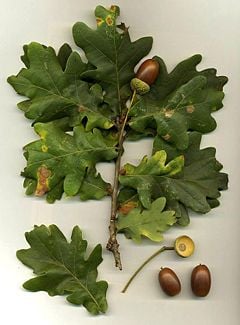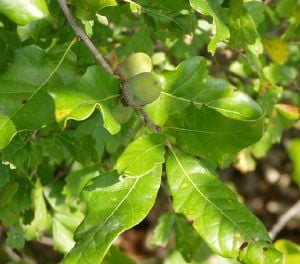Oak
| Oaks | ||||||||||||
|---|---|---|---|---|---|---|---|---|---|---|---|---|
 Foliage and acorns of Quercus robur
| ||||||||||||
| Scientific classification | ||||||||||||
| ||||||||||||
The term oak can be used as part of the common name of any of several hundred species of trees and shrubs in the genus Quercus (from Latin "oak tree"), and some related genera, notably Cyclobalanopsis and Lithocarpus. The genus is native to the northern hemisphere, and includes deciduous and evergreen species extending from cold latitudes to tropical Asia and the Americas.
Oaks have spirally arranged leaves, with a lobed margin in many species; some have serrated leaves or entire leaves with a smooth margin. The flowers are catkins, produced in spring. The fruit is a nut called an acorn, borne in a cup-like structure known as a cupule; each acorn contains one seed (rarely two or three) and takes 6-18 months to mature, depending on species. The "live oaks" (oaks with evergreen leaves) are not a distinct group, instead with their members scattered among the sections below.
Classification
The genus is divided into a number of sections:
- Sect. Quercus (synonyms Lepidobalanus and Leucobalanus), the oaks of Europe, Asia and North America. Styles short; acorns mature in 6 months, sweet or slightly bitter, inside of acorn shell hairless. Leaves mostly lack a bristle on lobe tips, which are usually rounded.
- Sect. Mesobalanus, the Hungarian oak and its relatives of Europe and Asia. Styles long; acorns mature in 6 months, bitter, inside of acorn shell hairless (closely related to sect. Quercus and sometimes included in it).
- Sect. Cerris, the Turkey oak and its relatives of Europe and Asia. Styles long; acorns mature in 18 months, very bitter, inside of acorn shell hairless. Leaves typically have sharp lobe tips, with bristles at the lobe tip.
- Sect. Protobalanus, the Canyon live oak and its relatives, in southwest United States and northwest Mexico. Styles short, acorns mature in 18 months, very bitter, inside of acorn shell woolly. Leaves typically have sharp lobe tips, with bristles at the lobe tip.
- Sect. Lobatae (synonym Erythrobalanus), the red oaks of North America, Central America and northern South America. Styles long, acorns mature in 18 months, very bitter, inside of acorn shell woolly. Leaves typically have sharp lobe tips, with spiny bristles at the lobe tip.
Hybrids are common in oaks but usually only between species within the same section; no verified inter-section hybrids are known, except between species of sections Quercus and Mesobalanus, where several occur.
The genus Cyclobalanopsis, here treated as a distinct genus following the Flora of China, is often included within Quercus as a distinct subgenus.
Uses
Oaks are hardwood trees, and the wood is commonly used in furniture and flooring. Oak wood has a density of about 0.75 g/cm³.
The bark of Quercus suber, or Cork oak, is used to produce wine stoppers (corks). This species grows in the Mediterranean Sea region, with Portugal, Spain, Algeria and Morocco producing most of the world's supply. Some European and American oak species are used to make barrels where wine and other spirits are aged; the barrels, which are in some cases charred before use, contribute to the taste, aroma, and color of the contents.
Of the North American oaks, the Northern red oak Quercus rubra is the most prized of the red oak group for lumber, all of which is marketed as red oak regardless of the species of origin. The standard for the lumber of the white oak group, all of which is marketed as white oak, is the White Oak Quercus alba. White Oak is often used to make wine barrels. The wood of Pedunculate Oak Quercus robur and Sessile Oak Quercus petraea are extensively used in Europe.
The bark of the White Oak is dried and used in medical preparations. Oak bark is also rich in tannin, and is used by tanners for tanning leather. Acorns are used for making flour or roasted for acorn coffee. Oak galls were used for centuries as the main ingredient in manuscript ink, harvested at a specific time of year.
Japanese oak is used in the making of professional drums from manufacturer Yamaha Drums. The rough, hard surface of oak gives the drum a brighter and louder tone compared to traditional drum materials such as maple and birch.
Diseases and pests
Sudden Oak Death (Phytophthora ramorum) is a water mould that can kill oaks within just a few weeks. Oak Wilt, caused by the fungus Ceratocystis fagacearum (a fungus closely related to Dutch Elm Disease), is also a lethal disease of some oaks, particularly the red oaks (the white oaks can be infected but generally live longer). Other dangers include wood-boring beetles, as well as root rot in older trees which may not be apparent on the outside, often only being discovered when the trees come down in a strong gale. Oaks are used as food plants by the larvae of Lepidoptera species.
- See also list of Lepidoptera which feed on Oaks
K4t13 + J355
8FF1!
G4881 + 1ZZY
8FF1!
Cultural significance
The oak is a common symbol of strength and endurance and has been chosen as the national tree of England, France, Germany, the United States and Wales.
Thor's Oak was a sacred tree of the Germanic Chatti tribe. Its destruction marked the Christianisation of the heathen tribes by the Franks[citation needed].
In the Bible, the oak tree at Shechem is the site where Jacob buries the foreign gods of his people (Gen. 35.4) . In addition, Joshua erects a stone under an oak tree as the first covenant of the Lord (Josh. 24.25-7). See other examples from the Bible.
In Classical mythology the oak was a symbol of Zeus and his sacred tree.
Several individual oak trees, such as the Royal Oak in Britain and the Charter Oak in the United States, are of great historical or cultural importance; for a list of important oaks, see Individual oak trees.
Iowa has designated the oak as its official state tree in 1961, and the White Oak is the state tree of Connecticut, Illinois and Maryland.
"Ambrosian Oaks" set to the Finlandia Hymn is the school song of St. Ambrose University in Davenport, Iowa.
The oak is the emblem of County Londonderry in Northern Ireland, as a vast amount of the county was covered in forests of the tree until relatively recently. The name of the county comes from the city of Derry, which originally in Irish was known as Doire meaning oak.
There is a proverb, "Mighty oaks from little acorns grow." Another is: "Every majestic oak tree was once a nut who stood his ground."
Many woods are connected to certain birth months, according to the Irish, and oak is the wood of June/July. However, in some variations, rosewood has been known to be June's wood [citation needed].
Raleigh, North Carolina has been nicknamed the "City of Oaks."
The Romania national rugby union team is nicknamed The Oaks.
In Celtic mythology it is the tree of doors, believed to be a gateway between worlds, or a place where portals could be erected.
Oak leaves are used to symbolize rank in the United States Armed Forces. A gold oak leaf indicates an O-4 (Major or Lt. Commander), whereas a silver oak leaf indicates an O-5 (Lt. Colonel or Commander). Arrangements of oak leaves, acorns and sprigs indicate different branches of the United States Navy Staff corps officers.
Historical note on Linnaean species
Linnaeus described only five species of oak from eastern North America, based on general leaf form. These were White oak, Q. alba, Chestnut oak, Q. montana, Red oak, Q. rubra, Willow oak, Q. phellos, and Water oak, Q. nigra. Because he was dealing with confusing leaf forms, the Q. prinus and Q. rubra specimens actually included mixed foliage of more than one species. For that reason, some taxonomists in the past proposed different names for these two species (Q. montana and Q. borealis, respectively), but the original Linnaean names have now been lectotypified with only the specimens in Linnaeus' herbarium that refer to the species the names are applied to now.
References and notes
A Pedunculate oak in Denmark
External links
- Flora of North America: Quercus
- Flora of China: Quercus
- Flora Europaea: Quercus
- Oak Trees of the Lowcountry (South Carolina) — Beaufort County Library
Credits
New World Encyclopedia writers and editors rewrote and completed the Wikipedia article in accordance with New World Encyclopedia standards. This article abides by terms of the Creative Commons CC-by-sa 3.0 License (CC-by-sa), which may be used and disseminated with proper attribution. Credit is due under the terms of this license that can reference both the New World Encyclopedia contributors and the selfless volunteer contributors of the Wikimedia Foundation. To cite this article click here for a list of acceptable citing formats.The history of earlier contributions by wikipedians is accessible to researchers here:
The history of this article since it was imported to New World Encyclopedia:
Note: Some restrictions may apply to use of individual images which are separately licensed.





